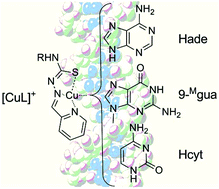Selectivity of a thiosemicarbazonatocopper(ii) complex towards duplex RNA. Relevant noncovalent interactions both in solid state and solution†
Abstract
Thiosemicarbazones and their metal derivatives have long been screened as antitumor agents, and their interactions with DNA have been analysed. Herein, we describe the synthesis and characterization of compounds containing [CuL]+ entities (HL = pyridine-2-carbaldehyde thiosemicarbazone) and adenine, cytosine or 9-methylguanine, and some of their corresponding nucleotides. For the first time, crystal structures of adenine- and 9-methylguanine-containing thiosemicarbazone complexes are reported. To the best of our knowledge, the first study on the affinity thiosemicarbazone–RNA is also provided here. Experimental and computational studies have shown that [CuL(OH2)]+ entities at low concentration intercalate into dsRNA poly(rA)·poly(rU) through strong hydrogen bonds involving uracil residues and π–π stacking interactions. In fact, noncovalent interactions are present both in the solid state and in solution. This behaviour diverges from that observed with DNA duplexes and creates an optimistic outlook in achieving selective binding to RNA for subsequent possible medical applications.



 Please wait while we load your content...
Please wait while we load your content...